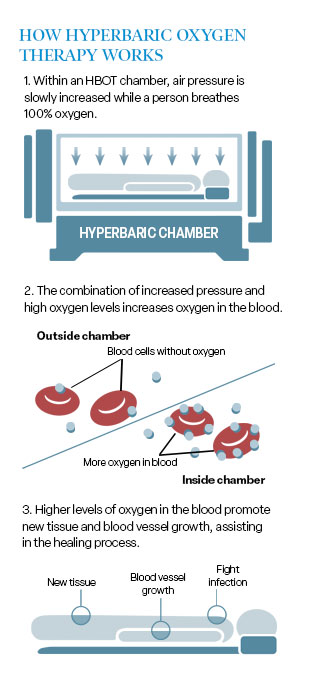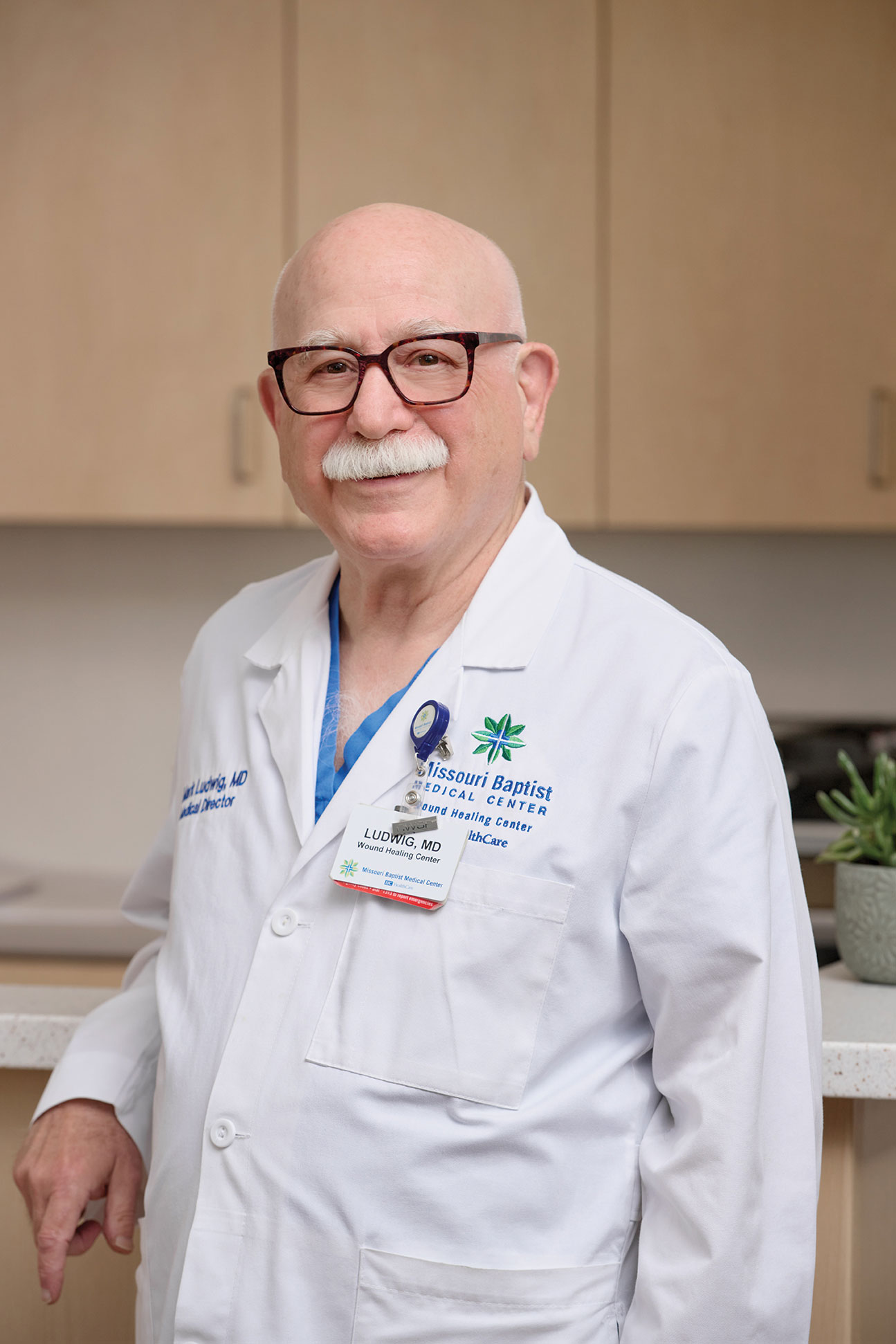As an executive chef at Hollywood Amphitheater and Dolan Memory Care, Mark DuBro spends a lot of time on his feet. It’s how a blister formed on the bottom of his foot by the base of his big toe. Over time, the wound progressed to a grade 3 non-healing wound or ulcer.
“I have neuropathy in my feet, which is a result of my diabetes,” Mark explains. Neuropathy is numbness or tingling caused by damaged nerves and can aggravate foot wounds and infections.
Mark Ludwig, MD, vascular surgeon and medical director of the Wound Healing Center at Missouri Baptist Medical Center (MoBap), says that with diabetes, high levels of blood sugar can cause damage to the tiny blood vessels supplying oxygen and nutrients to the feet and hands. Without oxygen and nutrients, sores and infections become more likely, and wounds can become life-threatening. “There are 25.8 million people living with diabetes in the United States, and twenty percent of diabetics will develop a foot ulcer.”
Mark says he was in pain every day and his wound affected his ability to work and participate in activities he enjoyed, including biking, pickleball, woodworking and spending quality time with his two granddaughters.
Mark went to his podiatrist for help and received a treatment called wound debridement. “The wound was cleaned, and special dressings were applied, but it wasn’t healing,” he explains.
Mark says that his foot wound was debilitating. “I felt like my life was on hold,” he says. “My professional career suffered. As a chef, I am on my feet 13 hours a day. Eventually, I had to cut back my hours because I could only stand and walk for 20 to 25 minutes.”
Mark Receives Hyperbaric Oxygen Therapy
Mark’s podiatrist referred him to the Wound Healing Center, where he met Dr. Ludwig, who examined his wound and took measurements. After assessing the wound and discussing regular advanced wound care, Dr. Ludwig recommended hyperbaric oxygen therapy (HBOT).
 “With HBOT, patients are in a chamber where they breathe 100 percent pressurized oxygen. The pressure pushes oxygen further out into the tissues and helps reduce inflammation, which aids healing and wound closure,” Dr. Ludwig says. “When foot wounds like Mark’s are left untreated, the risk for complications like infections, hospitalizations, and amputations increase drastically.”
“With HBOT, patients are in a chamber where they breathe 100 percent pressurized oxygen. The pressure pushes oxygen further out into the tissues and helps reduce inflammation, which aids healing and wound closure,” Dr. Ludwig says. “When foot wounds like Mark’s are left untreated, the risk for complications like infections, hospitalizations, and amputations increase drastically.”
At first, Mark was apprehensive about HBOT because he worried about getting claustrophobic in the chamber, but he quickly felt at ease after Mindy, LPN, and HBO safety coordinator, explained what to expect and showed him the chamber. “It’s made of glass so that you can see out, and there is a monitor above the chamber for watching TV or movies,” Mark says. “Mindy also assured me that someone would always be in the room during my treatment, and I could talk to them.”
Beginning in March 2023, Mark went to the Wound Healing Center Monday through Friday for ten weeks and had 50 treatments, each lasting two hours. “I didn’t experience claustrophobia and found the experience relaxing,” he says. “It wasn’t painful, and at the beginning of each treatment, I felt pressure in my ears like flying on a plane.”
After two weeks of treatment, Mark started to see improvement. Every Tuesday, Dr. Ludwig measured and evaluated the wound. This included dressing changes and removing dead tissue or debris from the wound for proper healing. Mark also changed the dressing on his foot daily and wore a walking boot to protect the wound.
By June 2023, Mark’s wound was finally closed and healed.
Healthy Tissue & Healing
After three years of discomfort, Mark can walk and stand without pain and is back to work full-time and has resumed his active lifestyle. With more education about the prevention of foot ulcers, he keeps an eye on the healed area, knowing he can reach back out to the Wound Healing Center if there are changes and have one of the providers examine him.
Mark is thankful to everyone in the Wound Healing Center who helped him get back on his feet and says HBOT was “life-changing.”
He recalls the feeling of freedom he experienced during his first 30-mile bike ride on the Katy Trail after his foot was healed. “I’m back to doing all the activities I love,” he says. “Most importantly, healing has allowed me to participate again in my granddaughters’ lives, whether we go to the zoo, swim or simply play on the swings. That means the world to me.”
About the Wound Healing Center
 The Wound Healing Center offers state-of-the-art treatments, including specialty wound dressings and wraps, debridement, offloading devices, negative pressure wound therapy, cellular tissue-based and bioengineered skin substitutes, HBOT, and patient education for people with non-healing and chronic wounds. The Center recently expanded its space to include two more exam rooms and a spacious entry and waiting area.
The Wound Healing Center offers state-of-the-art treatments, including specialty wound dressings and wraps, debridement, offloading devices, negative pressure wound therapy, cellular tissue-based and bioengineered skin substitutes, HBOT, and patient education for people with non-healing and chronic wounds. The Center recently expanded its space to include two more exam rooms and a spacious entry and waiting area.
As part of the Healogics™ nationwide network, the Wound Healing Center has access to a vast database of wound care information, such as national benchmarking and the latest research, best practices, education and technology advancements in wound care, which is essential for the best healing success.
“The wounded patient population is growing, and wounds are complex conditions, requiring a treatment plan tailored to each patient’s needs,” says Dr. Ludwig. “Our team uses proven, research-based approaches during each stage of the treatment process to improve the healing rate and reduce the timeline for recovery.”
Wound Healing Center program director Zehra Kujundzic, MHA, CRA, RT(R), says that the nursing team ensures all needs for the most successful outcome are met, including helping patients and families with durable medical equipment, education and arranging fittings for prosthetics and shoes.